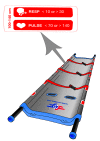A concept for major incident triage: full-scaled simulation feasibility study
- PMID: 20701802
- PMCID: PMC2928192
- DOI: 10.1186/1471-227X-10-17
A concept for major incident triage: full-scaled simulation feasibility study
Abstract
Background: Efficient management of major incidents involves triage, treatment and transport. In the absence of a standardised interdisciplinary major incident management approach, the Norwegian Air Ambulance Foundation developed Interdisciplinary Emergency Service Cooperation Course (TAS). The TAS-program was established in 1998 and by 2009, approximately 15 500 emergency service professionals have participated in one of more than 500 no-cost courses. The TAS-triage concept is based on the established triage Sieve and Paediatric Triage Tape models but modified with slap-wrap reflective triage tags and paediatric triage stretchers. We evaluated the feasibility and accuracy of the TAS-triage concept in full-scale simulated major incidents.
Methods: The learners participated in two standardised bus crash simulations: without and with competence of TAS-triage and access to TAS-triage equipment. The instructors calculated triage accuracy and measured time consumption while the learners participated in a self-reported before-after study. Each question was scored on a 7-point Likert scale with points labelled "Did not work" (1) through "Worked excellent" (7).
Results: Among the 93 (85%) participating emergency service professionals, 48% confirmed the existence of a major incident triage system in their service, whereas 27% had access to triage tags. The simulations without TAS-triage resulted in a mean over- and undertriage of 12%. When TAS-Triage was used, no mistriage was found. The average time from "scene secured to all patients triaged" was 22 minutes (range 15-32) without TAS-triage vs. 10 minutes (range 5-21) with TAS-triage. The participants replied to "How did interdisciplinary cooperation of triage work?" with mean 4,9 (95% CI 4,7-5,2) before the course vs. mean 5,8 (95% CI 5,6-6,0) after the course, p < 0,001.
Conclusions: Our modified triage Sieve tool is feasible, time-efficient and accurate in allocating priority during simulated bus accidents and may serve as a candidate for a future national standard for major incident triage.
Figures




Similar articles
-
Triage performance of Swedish physicians using the ATLS algorithm in a simulated mass casualty incident: a prospective cross-sectional survey.Scand J Trauma Resusc Emerg Med. 2013 Dec 20;21:90. doi: 10.1186/1757-7241-21-90. Scand J Trauma Resusc Emerg Med. 2013. PMID: 24355021 Free PMC article.
-
Major incident in Kent: a case report.Scand J Trauma Resusc Emerg Med. 2015 Sep 22;23:71. doi: 10.1186/s13049-015-0152-9. Scand J Trauma Resusc Emerg Med. 2015. PMID: 26391879 Free PMC article.
-
Attitudes Towards and Experience of the Use of Triage Tags in Major Incidents: A Mixed Method Study.Prehosp Disaster Med. 2016 Aug;31(4):376-85. doi: 10.1017/S1049023X16000480. Epub 2016 May 23. Prehosp Disaster Med. 2016. PMID: 27212424
-
[Terrorist attack training exercise-What can be learned? : Baden-Württemberg counterterrorism exercise (BWTEX)].Anaesthesist. 2020 Jul;69(7):477-486. doi: 10.1007/s00101-020-00797-4. Anaesthesist. 2020. PMID: 32488534 Review. German.
-
Triage in Complex, Coordinated Terrorist Attacks.Prehosp Disaster Med. 2019 Aug;34(4):442-448. doi: 10.1017/S1049023X1900459X. Prehosp Disaster Med. 2019. PMID: 31389325 Review.
Cited by
-
Comparison of prehospital professional accuracy, speed, and interrater reliability of six pediatric triage algorithms.J Am Coll Emerg Physicians Open. 2022 Jan 14;3(1):e12613. doi: 10.1002/emp2.12613. eCollection 2022 Feb. J Am Coll Emerg Physicians Open. 2022. PMID: 35059689 Free PMC article.
-
Study of the severity of musculoskeletal injuries and triage during the 2005 Pakistan earthquake.Int Orthop. 2013 Aug;37(8):1443-7. doi: 10.1007/s00264-013-2013-3. Epub 2013 Jul 11. Int Orthop. 2013. PMID: 23842631 Free PMC article.
-
Systematic review of strategies to manage and allocate scarce resources during mass casualty events.Ann Emerg Med. 2013 Jun;61(6):677-689.e101. doi: 10.1016/j.annemergmed.2013.02.005. Epub 2013 Mar 20. Ann Emerg Med. 2013. PMID: 23522610 Free PMC article.
-
Prioritized Criteria for Casualty Distribution following Trauma-related Mass Incidents; a Modified Delphi Study.Arch Acad Emerg Med. 2020 Apr 7;8(1):e47. eCollection 2020. Arch Acad Emerg Med. 2020. PMID: 32309811 Free PMC article.
-
Rapid extrication of entrapped victims in motor vehicle wreckage using a Norwegian chain method - cross-sectional and feasibility study.BMC Emerg Med. 2014 Jul 3;14:14. doi: 10.1186/1471-227X-14-14. BMC Emerg Med. 2014. PMID: 24989364 Free PMC article.
References
-
- Advanced Life Support Group (Ed.) Major Incident Medical Management and Support, the Practical Approach at the scene. Second. Plymouth, UK: BMJ Publishing Group; 2002.
-
- Aylwin CJ, Konig TC, Brennan NW, Shirley PJ, Davies G, Walsh MS, Brohi K. Reduction in critical mortality in urban mass casualty incidents: analysis of triage, surge, and resource use after the London bombings on July 7, 2005.[see comment] Lancet. 2006;368:2219–2225. doi: 10.1016/S0140-6736(06)69896-6. - DOI - PubMed
-
- Seynaeve G, Archer F, Fisher J, Lueger-Schuster B, Rowlands A, Sellwood P, Vandevelde K, Zigoura A. International standards and guidelines on education and training for the multi-disciplinary health response to major events that threaten the health status of a community. Prehosp Disaster Med. 2004;19:S17–30. - PubMed
-
- Hodgetts T, Hall J, Maconochie I, Smart C. Paediatric triage tape. Pre-Hospital Immediate Care. 1998;2:155–159.
Publication types
MeSH terms
LinkOut - more resources
Full Text Sources
Medical

